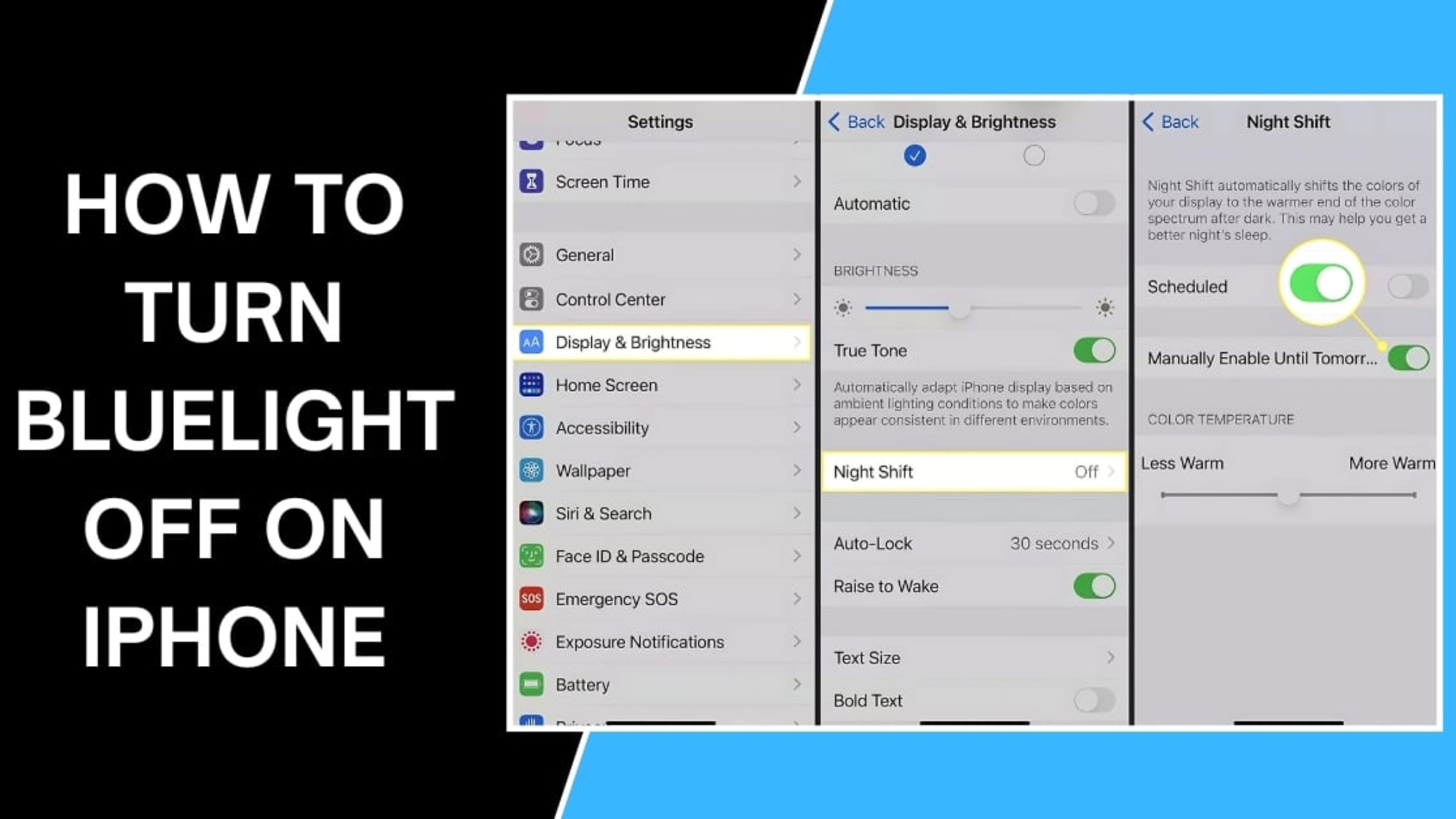Wondering how to turn bluelight off on iPhone? If your screen feels too bright at night or your eyes feel strained after scrolling, your iPhone has built-in tools to fix it. This post shows you how to use the iPhone blue light filter to reduce glare, protect your eyes, and sleep better.
You’ll learn how to turn on the blue light filter on your iPhone. We’ll also cover helpful settings like True Tone, Dark Mode, and Reduce White Point. Plus, we’ll show you how to use Siri to activate Night Shift and if Night Shift isn’t working, we’ve got simple fixes that solve the most common issues fast.
If you’re ready to stop blue light the easy way and finally learn how to turn it off on your iPhone without the confusion, this step-by-step guide will help you to know everything.
What Is Blue Light and Why Should You Care?
You’ve probably heard the term “blue light” before but what is it? It’s a type of light that comes from screens like your phone, tablet, laptop, and even LED bulbs.
It’s a type of visible light that keeps you alert and awake which is great when you’re trying to power through the workday or stay focused during a Zoom call. But at night? Not so great.
Your body has this hormone called melatonin which helps you relax and fall asleep. When you’re exposed to blue light late in the evening (say, scrolling in bed), it can trick your brain into thinking it’s still daytime.
In fact, Harvard Health notes that nighttime blue light exposure can throw off your sleep rhythm by blocking melatonin.
The Benefits of Using a Blue Light Filter on Your iPhone
Turning on a blue light filter on an iPhone has several helpful benefits:
- Reduces eye strain at night
- Helps your body prepare for sleep
- Makes screen brightness feel less harsh
- Improves comfort when reading or watching content in the dark
These changes may seem small, but they make a big difference over time.
How to Turn BlueLight Off on iPhone
Tired of your screen being too bright at night? Your iPhone has a setting called Night Shift that makes the screen warmer, so it’s easier on your eyes (and better for sleep).
Here’s how to turn it on
- Open the Settings app.
- Tap Display & Brightness
- Select Night Shift
- Choose one of the following:
- Tap Turn On Until Tomorrow to activate it now.
- Tap Scheduled and choose either Sunset to Sunrise or set custom times.
This built-in feature works as an iPhone blue light filter and takes less than 30 seconds to turn on.
How to Use the iPhone Blue Light Filter (Night Shift Explained)
Night Shift is Apple’s official feature that helps reduce blue light by adjusting your screen’s color temperature.
You can use it in two ways:
Manually: Turn it on or off whenever you need it.
Automatically: Set a custom schedule or let it run from sunset to sunrise.
To adjust the filter strength:
Go to Settings > Display & Brightness > Night Shift
Use the slider to choose how warm or cool your screen should appear.
The warmer the tone, the less blue light your eyes will absorb. This setting helps you wind down and avoid unnecessary screen strain before sleep.
Use Siri to Turn On Night Shift (Night Light iPhone Feature)
Want to make it even easier? You can use Siri to turn on Night Shift without touching your screen.
Just say:
“Hey Siri, turn on Night Shift”
This voice command works instantly and is perfect when your hands are full or you’re already in bed. It activates your night light iPhone setup without needing to open the Settings app.
Note: Techy offers all kinds of gadget repair services, whether you need iPhone repair, cell phone repair, game console repair, computer repair, smart watch repair, iPad repair, and more.
Extra Tips to Stop Blue Light on iPhone
Night Shift is great on its own but there are a few bonus settings that can make your screen feel even easier on the eyes. It makes a big difference if you tend to scroll at night:
- True Tone: This adjusts your screen based on the lighting around you. Things look more natural and softer overall.
→ Find it under: Settings > Display & Brightness > True Tone
- Dark Mode: Swaps out bright backgrounds for darker ones. It is easier on the eyes and it looks pretty slick too.
→ Enable it in: Settings > Display & Brightness > Appearance
- Reduce White Point: If even the dimmest setting still feels too bright, this one tones down the intensity of whites on your screen.
→ Try: Settings > Accessibility > Display & Text Size > Reduce White Point
Night Shift Not Working? Here’s How to Fix It
If Night Shift isn’t working on your iPhone, don’t worry. It’s usually an easy fix. Here are some quick ways to troubleshoot it:
- Can’t find it in settings? Night Shift is available on iPhones running iOS 9.3 or later. Make sure your software is up to date.
- Not activating on schedule? Go to Settings > General > Date & Time and turn on Set Automatically. Scheduling depends on the correct time zone.
- Using Low Power Mode? Some background features like Night Shift may turn off to save battery.
- Still, having trouble? Restart your iPhone, or go to Settings > General > Transfer or Reset iPhone > Reset > Reset All Settings to clear display glitches.
In most cases, one of these steps will get Night Shift working again in seconds so you can keep blocking blue light without interruption.
Bottom Line
Now you know how to turn bluelight off on your iPhone and why that small change makes a big difference. Features like Night Shift, True Tone, and Reduce White Point help reduce glare and ease eye strain.
You’ve learned how to use the iPhone blue light filter, set up the blue light filter on iPhone with Night Shift and adjust your screen for a more relaxing nighttime experience. These settings make it easier to stop blue light from disrupting your rest, without installing any extra apps.
If you ever need help customizing your iPhone display or fixing other screen-related issues, Techy Company is here to help. We offer real support, clear advice, and trusted solutions to make your devices work better for you.
Take a minute today to adjust your settings. Your eyes, your sleep, and your screen time will all feel better for it.
Frequently Asked Questions
Warm tones like amber or soft yellow are best for sleep. These reduce exposure to blue light, which helps your body release melatonin naturally. Avoid bright white or cool blue shades before bed because they can keep your brain alert longer than you’d like.
To turn off the blue light on your iPhone 11, open Settings > Display & Brightness > Night Shift. From there, you can either turn it on manually or set a schedule. Slide the bar toward “warmer” to filter out more blue light and reduce eye strain at night.
Night Shift is Apple’s built-in blue light filter. It adjusts your screen colors to warmer tones in the evening and helps your eyes relax and your body prepare for sleep. You can find it under Display & Brightness and set it to run automatically each night.
The small blue or green dot near your iPhone 13’s front camera is a privacy indicator. It tells you when your camera (green) or microphone (orange) is active. This is Apple’s way of letting you know that an app is recording or listening.
To block blue light on a Samsung phone, go to Settings > Display > Eye Comfort Shield or Blue Light Filter. Turn it on manually or schedule it for night use. Adjust the warmth level if you want a softer display. It works just like Night Shift on iPhone.
Go to Settings > Display & Brightness > Night Shift on your iPhone 14.
You can activate it instantly or schedule it to turn on at night. Use the slider to shift your screen to a warmer color . This helps your eyes relax and makes bedtime scrolling less harsh.
Android phones usually include a Night Light or Eye Comfort mode. Open Settings > Display, and look for Blue Light Filter, Night Light, or similar. You can turn it on manually or set a schedule. This feature helps you stop blue light and reduce screen strain.


Add a Comment